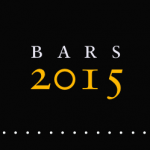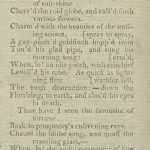Last week Team Lady’s Magazine attended the wonderful 2015 BARS conference “Romantic Imprints” at Cardiff University. This was very exciting: BARS conferences always draw an international crowd with diverse research specialisms, and as we have so far mostly engaged with eighteenth century scholars, we were eager to present our work to people who at least to some extent identify as Romanticists. We learned much from the generous feedback of our audience, and we flatter ourselves that we had a thing or two to suggest in turn.
Imprints” at Cardiff University. This was very exciting: BARS conferences always draw an international crowd with diverse research specialisms, and as we have so far mostly engaged with eighteenth century scholars, we were eager to present our work to people who at least to some extent identify as Romanticists. We learned much from the generous feedback of our audience, and we flatter ourselves that we had a thing or two to suggest in turn.
After all, although the magazine runs until 1832 and therefore spans the whole of the Romantic era as it is traditionally demarcated, and features a great number of authors, themes and social issues that Romanticists are interested in, it is usually mentioned only in the footnotes to studies of early-nineteenth-century print culture. To help clarify this neglect, I will in this post briefly touch upon two prejudices that persist in literary studies, and which I think could quite easily be remedied. It goes without saying that not all discussions of the Romantic-era Lady’s Magazine betray these popular misconceptions, and when they do appear, this is often the case for understandable reasons.
- ‘The Lady’s Magazine’s amateur authors become irrelevant in the age of Personality and Genius.’
One of the major goals of our research project is to find out more about the Lady’s Magazine’s countless anonymous, near-anonymous and pseudonymous reader-contributors; literally thousands of amateur authors who submitted unsolicited copy. The contributions by these at best sparsely documented readers form the bulk of the magazine’s content, the rest mainly consisting of republications from recent books and other periodicals. Unfortunately, there are two Romantic phenomena that distract attention from these reader-contributors, i.e. the closely related notions of “Personality” and “Genius”.
The Lady’s Magazine only partially confirms the accepted account of a movement towards professional authorship in the literary marketplace, which is usually said to occur gradually throughout the eighteenth century. From around 1800 we do attest a relative increase of republished material, but reader-contributors certainly do not disappear. On the contrary, they retain their predominance until the very end. Reader-contributors help make or break the reputations of more famous authors and establish trends by following or dismissing the latter’s example, and sometimes create a (minor) stir in their own right by following up their unremunerated periodical publications with books of their own. Literature functions in a market place, and, as is common knowledge, the movement towards professionalization is closely tied to publishers’ commercial strategies. Recognizable “Personalities” who all but belonged to specific publications, and who could be pitted against each other, were much easier to market than nearly invisible writers furnishing the odd contribution here and there. In Romantic studies, much attention has gone to periodicals that played out this trend magisterially, e. g. Blackwood’s Edinburgh Magazine and the Examiner. The Lady’s Magazine instead conceptualizes itself as an inclusive forum where individual authors are less conspicuous, and therefore it does not fit this model. It is therefore easily overlooked.

LM XXXI (March 1800): 272. Image © Adam Matthew Digital / Birmingham Central Library. Not to be reproduced without permission
Related to this concern is the so-called Romantic cult of Genius, which in the past few decades has of course been thoroughly analysed and revealed to have been an intricate cluster of ideological, aesthetic and philosophical factors. Few if any scholars these days still read the major Romantic poets as visionaries driven solely by their hallowed vocation. However, it is hard to deny that the prominence that this defunct idea brought to certain poetic modes (and in some ways the essay) has obfuscated the presence of others in the early-nineteenth-century literary market, and discouraged scholarship on other literary genres, such as the novel. It has also brought with it a disregard for the many amateur writers who populated the magazines of their day, foremost the Lady’s Magazine. In the year 1800, the magazine reprinted without signature poems from the Lyrical Ballads, which appear alongside verse by the now obscure weaver-poet John Webb, who was a celebrated contributor to the magazine for several years. Yet, comparatively speaking, do academics publish many sophisticated rhetorical and philosophical analyses of the work of the countless Webbs of the period, who were as much part of their age as any Wordsworth? We at Team Lady’s Magazine maintain that the term “amateur” should be divested permanently of all negative connotations; it should not be an implicit insult but merely an indicator that the author’s primary source of income was not her/his writing. As to the relative intrinsic value of literary texts; that is not a call that we like to make, rather starting from an impartial study of their respective reception history.
- ‘Periodicals like the Lady’s Magazine are formulaic and intellectually unchallenging.’
Although the situation has certainly improved over the last few years, the distinctions between Romantic-era and eighteenth-century periodicals are often exaggerated. There is a notion that Britain wipes the slate clean after the end of the Napoleonic Wars (how topical!) and that the periodical market reinvents itself to reflect new economic realities and political ideals. Of course these factors exerted an influence on the development of magazines, but this did not happen in one cataclysmic moment. It is rather likely that the literary field of the High Romantic period would have been quite recognizable to any late-eighteenth-century author who had lived hidden in a picturesque ruin or on a sublime alp for twenty years.
In his impressively researched but negatively biased survey of literary prose in eighteenth-century magazines, Robert Mayo states that ‘most new magazine fiction published between 1740 and 1815 was lacking in vigor and permanent value’[1] and ‘predominantly decorous, sentimental, and moral’,[2] statements unlikely to induce readers to turn to the publications themselves to make up their own minds. As stated above, we do not wish to base our argument on value judgements, but a quick glance at several items in the Lady’s Magazine might convince sceptics that every issue contains at least a few items that look ahead to tropes and themes that we now associate with famous novels that came decidedly after they are introduced there. It is also anachronistic to look for some sort of highbrow fiction that could be juxtaposed to Mayo’s supposed ‘predominantly decorous’ work. Readers or even critics tended not to make such a distinction in this period, and our own assessments are shaped by two hundred years of subsequent history, both political and aesthetic.
Besides these assumptions about popular themes, certain claims often made about the innovations of the nineteenth century in literary forms are revealed to be arbitrary when earlier magazines are examined. The Lady’s Magazine from its earliest issues contains a wealth of poetic forms that are commonly associated with the Romantic age, and it will be difficult to differentiate narratologically its many tales from the short stories that are commonly said to have been first featured in Romantic-era literary periodicals. When, indeed, does a ‘story which is short’ become a ‘short story’?
The non-fictional content of publications such as the Lady’s Magazine is routinely slighted as well. Women’s periodicals originating in the late eighteenth century have fared particularly badly because of an undue emphasis on what Kathryn Shevelow (after Jonathan Swift) has termed the ‘fair-sexing’ of these periodicals.[3] Professor Shevelow’s pioneering history of the gendering of eighteenth-century periodicals discerned in these an increasing prevalence of the notion of ‘the Fair Sex’, that would have prompted a dumbing-down of those magazines catering specifically for women. Hard science and philosophy would have been scrapped in favour of domestic interests. Due to an understandable need for generalization in her broad single-volume history, she represented this movement as a steady intellectual decline, ending in a low point at the end of the century. The conclusion, at least in the minds of many of Shevelow’s readers, is that only at the very end of the century an agonizingly slow recovery would have begun, headed by education reformists such as Catherine Macaulay and Mary Wollstonecraft. Although both are present in the Lady’s Magazine, this periodical is, allegedly, still one of the insipid mags.
We cannot deny that there are plenty of contributors, male and female, who believe that women have roles distinct from those of men, and should keep to them rigidly. Nevertheless, there is also a whole lot of material in the Lady’s Magazine that in no way fits the image of female domestication. There are long and detailed historical essays, technical introductions to mathematics that go well beyond the necessities for household accounts, and a variety of natural history items. Like for the other aspects of the magazine that have been discussed in this blog post, the situation is nuanced and thereby vulnerable to reductive readings.
In the near future we will release our annotated, open-access online index that will allow scholars to find out at a glance what the Lady’s Magazine could mean to their research. In the meantime we hope that you will continue to read our blogs and follow us on Twitter (@ladysmagproject). We intend to share a lot more that is directly relevant to the Romantic age!
Dr. Koenraad Claes
School of English, University of Kent
[1] Mayo, Robert. The English Novel in the Magazines: 1740-1815. Evanston: Northwestern University Press, 1962. p. 2
[2] idem. p. 188
[3] Shevelow, Kathryn. Women and Print Culture: The Construction of Femininity in the Early Periodical. London: Routledge, 1990. passim
